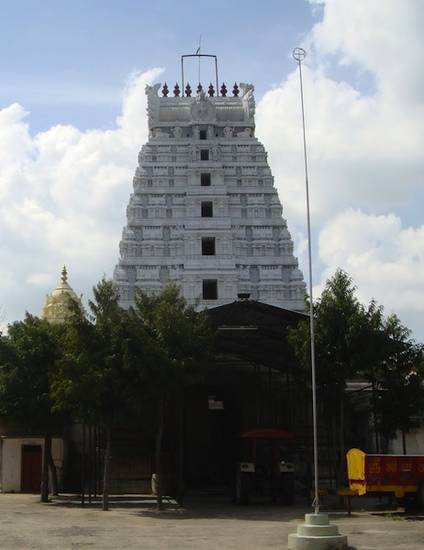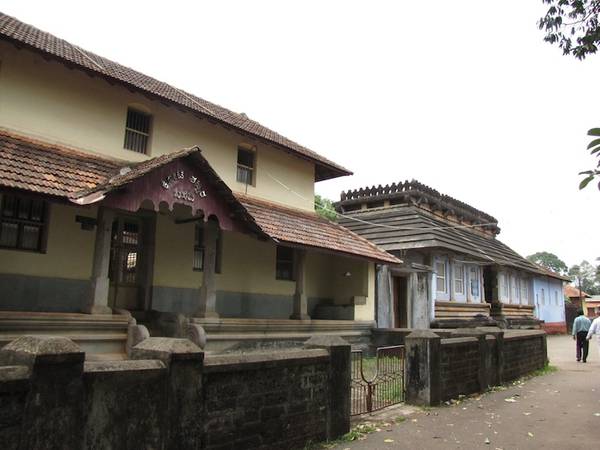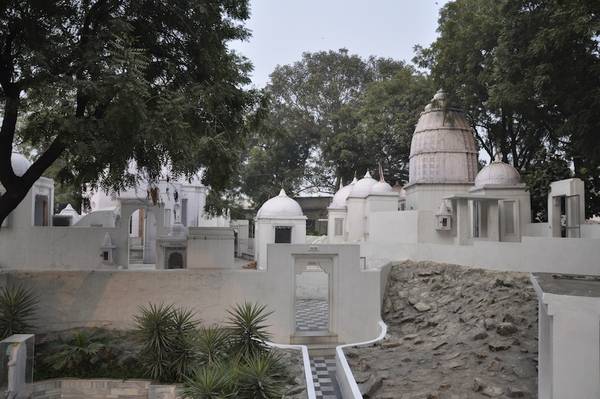Article: Temple-cities
Jain temple-cities are groupings of temple compounds, which contain large numbers of individual and interconnected temples and smaller shrines. They are walled and entered through gateways.
Temple-cities are not cities in the conventional sense. They do not contain streets, houses or shops. They are dedicated to the veneration of Jain values and the glory of the enlightened Jinas.
Most temple-cities are located on hills and have developed out of clusters of temples and walled compounds, which have been expanded over time. Donors give money to help build shrines and temples, which eventually form sizeable groups of temple compounds.
There are numerous examples of temple-cities throughout India. The best known include:
- Mount Girnār
- Mount Śatruñjaya
- Mount Sameṭa Śikhara
- Mount Sonā-giri
- Shravana Belgola
- Mudabidri.
Temple-cities are depicted on pilgrimage banners and in relief carvings at other Jain sites. Imitations of well-known temple-cities have also been built at smaller sites.
The creation of temple-cities in the form outlined here is unique to the Jain faith. Representations of temple-cities in Jain art and at other important Jain sites throughout India, and abroad, indicate the great importance of these holy sites for the Jain community.
Definition
A temple-city is a term for a large number of temples built very closely together. Jain temple compounds tend to contain a multitude of major temple buildings and minor shrine structures. Dense accumulations of such compounds are then referred to as temple-cities. Usually found in sites of religious importance, these are not conventional cities, because human beings do not live in them. Instead, Jains make pilgrimages to these temple-cities, which are devoted to spiritual matters.
Jain temple complexes are frequently altered and enlarged and there is no rule or convention as to when a large number of temple compounds can be described as a temple-city.
Architecture
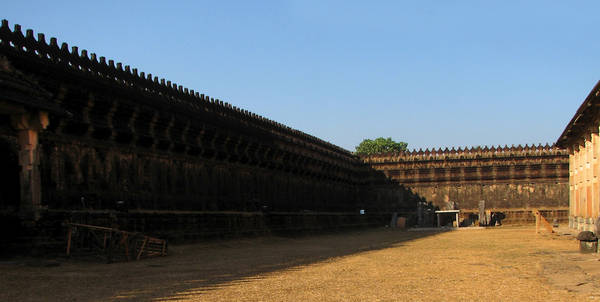
Walls of a temple compound
Image by Eric.Parker © CC BY-NC 2.0
There is a clear tendency in Jain temple architecture towards creating numerous shrines. This leads to the construction of temple buildings with many shrines and storeys, which are often surrounded by further free-standing and interconnected shrines. These collections of religious buildings frequently combine temples of different forms.
The religious buildings are regularly grouped into compounds and surrounded by high protective walls – prākāras. The enclosing walls can consist of uninterrupted lines of small shrines – deva-kulikās – which form a solid wall on the outside. The walled complexes – tunks – are strongly fortified. They have massive gateway structures and can be securely locked.
Location
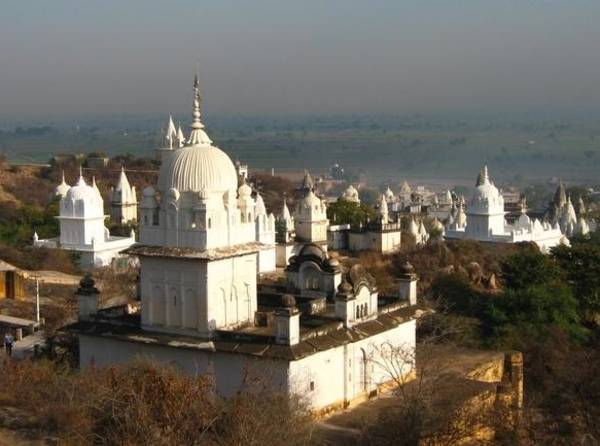
Temples at Sona-giri
Image by nkjain © CC BY-SA 2.0
By building several such walled compounds in one place, the Jains create so-called temple-cities at particularly important sites of pilgrimage. These sacred cities can contain several hundred temples and smaller shrines.
Many temple-cities are on raised ground or high mountain peaks. This is frequently indicated in their names, which bear the suffix ‘-giri’ – hill. Examples include Drona-giri and Naina-giri in Central India.
Visiting temple-cities
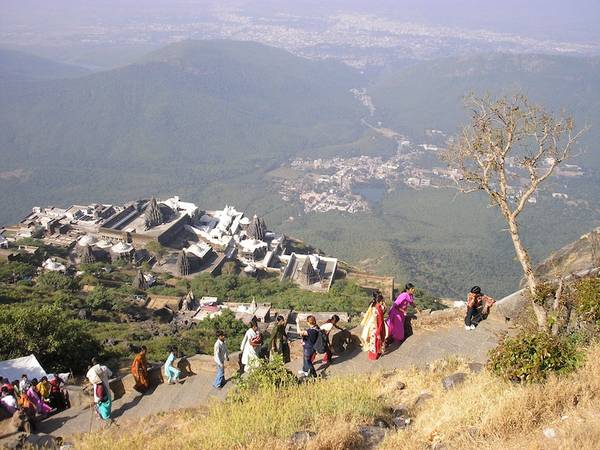
Pilgrimage at Girnar
Image by gatomato © CC BY-NC-SA 2.0
No human beings live in the temple-cities. There are no shops and houses, and no streets inside the cities. Therefore the temple-cities are not cities in a domestic or commercial sense.
Pilgrims and priests climb the hills in the morning, venerate the statues, clean the compounds and descend to their accommodation at night. People visiting the city walk barefoot on small, usually paved, paths, so that they can follow the concept of ahiṃsā – non-violence – and avoid stepping on minute creatures.
Many temple-cities contain large sub-complexes and group their temples into smaller sets. This helps pilgrims to find their way, since they usually visit the individual temples of a sacred site in an organised and ritually prescribed sequence. These temple clusters are regarded as pure spheres, which aid meditation and the development of a detached attitude towards the physical world. Focusing on spiritual progression instead of material concerns is what Jains should aim to do.
Development
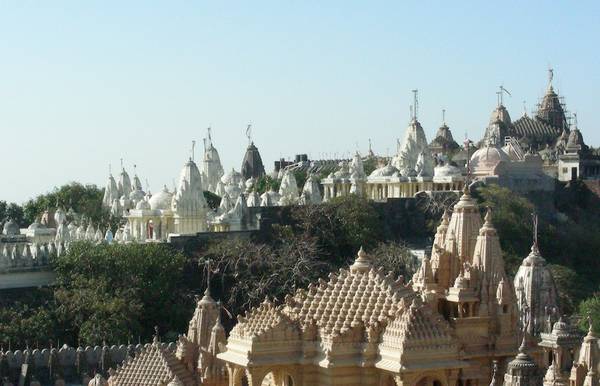
Temple-city of Mount Shatrunjaya
Image by liketearsintherain – tommy © CC BY-SA 2.0
Temple-cities have developed from the Jain custom of constructing many shrines close together. Temples and shrines are built with donations from lay Jains, who gain spiritual merit from this act. Holy sites that have special religious significance attract many donations over the centuries, meaning that popular pilgrimage centres are frequently very large and may well be described as temple-cities. A temple-city may develop from just two original temple compounds next to each other.
The various temples and shrines that comprise a temple-city are probably built over some time, rather than all at once. The buildings may therefore display a variety of architectural styles. Donors express their devotion by giving money towards the construction of impressive temples and entire temple-cities. Such donations also glorify the Jain religion and the 24 enlightened saintly teachers, the Jinas or Tīrthaṅkaras.
There is a smooth transition from a number of tightly grouped temple compounds to the creation of substantial, fully-fledged temple-cities. The more statues and donations a sacred site receives, the more it expands and comes closer to the ideal of the temple-city.
In many instances, this process starts with just two neighbouring temple complexes. In such cases, one is often administered by the Śvetāmbara sect and the other by the Digambara community. This is the case at Taranga and Idar, both located in Gujarat. However, double complexes do not only exist at jointly managed Jain sites. There are examples where two Śvetāmbara complexes are next to each other, as may be seen at Bikaner in Rajasthan.
Temple-cities across India
The development from temple compounds towards the creation of complete temple-cities can be found in all regions of India. The most famous temple-cities are the principal pilgrimage sites in the Jain faith.
North-western India
In the north-west of the subcontinent there are adjacent Jain compounds in several places. In Rajasthan neighbouring temples number:
- three at Rānakpur
- four at Mirpur
- five at Kumbharia
- six on Mount Ābū.
The latter case also illustrates the location of such clusters of large temple complexes on the summit of a hill. A further good example is the hill at Talaja in Gujarat, which consists of a great number of tightly grouped temple compounds.
The largest concentrations of temple compounds can be found on the sacred mountains of Girnār and Śatruñjaya, both in Gujarat. On Mount Girnār, near Junagadh, there are about six substantial walled complexes and many more stand-alone temples. On Mount Śatruñjaya, near the town of Palitana, between 800 to 900 temples are grouped in about ten substantial walled compounds, covering the two peaks and the valley between. Each of these Jain temple compounds contains a multitude of major temple buildings and minor shrine structures.
North and east India

Peaks of Mount Sammeta
Image by CaptVijay © public domain
The phenomenon of temple-cities can also be studied in the north and east of India. For instance, adjoining large temple compounds are comprised of:
- three at Sauripur in Uttar Pradesh
- four at Manicktolla in the north of Kolkata in West Bengal
- several at Hastinapur in Haryana
- five at Pavapuri in Bihar.
Also in Bihar, the town of Arrah alone accommodates forty Digambara Jain temples in the city centre.
Like other parts of the subcontinent, such accumulations of Jain temples are regularly located on hill tops. At Rajgir in Bihar, caves and temples of different construction styles are found on five sacred hills surrounding this ancient pilgrimage centre. The largest Jain temple-city in the east is the venerated hill site of Mount Paraśnātha. Also known as Mount Sameṭa Śikhara, it has developed near the village of Madhuban in Bihar.
Other examples include the temples and cave temples on:
- Mandar Hill in Bihar
- Pabhosa Hill in Uttar Pradesh
- the twin peaks of Udaya-giri and Khada-giri in Orissa.
Central India
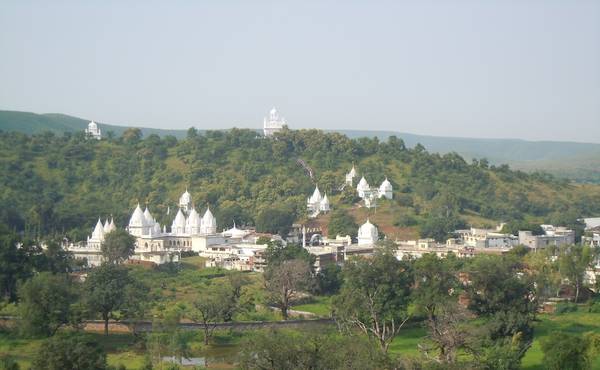
Temple-city of Kundalpur
Image by Adarshj4 © CC BY-SA 3.0
Accumulations of temples are equally popular and widespread in the central region of India.
In Madhya Pradesh, large numbers of temple complexes are found at:
- Mount Cūla-giri
- Deogarh
- Khajuraho
- Mandu
- the hill at Pisanhariki Mariya.
In Maharashtra the same phenomenon can be seen at Anjaneri and Ramtek, and on the sacred hills at:
- Gajpantha
- Kumbhoj, also known as Bāhubali Hill
- Maṅgī Tuṅgī.
There is no clear dividing line from where a large number of Jain temple compounds starts to be defined as a temple-city, and temple complexes are regularly enlarged and added to. Sites in the region that can be referred to as fully developed temple-cities are the mountains Droṇa-giri and Nainā-giri, with roughly forty temples each, and Papora and Mount Muktā-giri in Maharashtra with more than fifty shrines each.
At Kundalpur in Madhya Pradesh, the number of temples at one site is even larger, reaching up to sixty. The temples have been arranged around a central lake and on a crescent-shaped ridge enclosing half the lake.
The largest temple-city in the central region of India, however, is Mount Sonā-giri. This site boasts 108 individually numbered temples, spread over hilly terrain near Datia in Madhya Pradesh.
South India
It is common practice in the southern Indian states to have many temple compounds at pilgrimage sites.
In the small town of Shravana Belgola in Karnataka, for instance, the Arkaṇṇa Temple group consists of two walled compounds. At Varanga, in the same state, three religious complexes lie side by side, and at the site of Gommateshvara, near Mysore, five fenced sacred areas are grouped on and around the monumental central rock formation.
This tendency to build temple compounds next to each other has also led to the creation of so-called Jain temple-cities in the south. Those on Vindhya-giri and Candra-giri at Shravana Belgola, as well as the temple-city on Tirumalai in Tamil Nadu are dispersed over hill sites, with a concentration of temples towards the peak. The paths leading up the steep hills are lined by religious statues, small shrines and water structures.
As in other regions, not all Jain temple-cities in the south have been constructed on high peaks. The one at Melsittamur in Tamil Nadu, as well as the substantial Hiriangadi Temple complex at Karkala in Karnataka, have been created on level ground.
Urban temple-cities
Most Jain temple-cities are relatively isolated. They can be reached from towns or monastic settlements but are usually quite remote sites. An alternative form of the Jain temple-city is a dense complex of walled temple compounds in the centre of a city or in the main Jain quarters of a town.
This kind of urban temple-city can be found in Jaisalmer in Rajasthan, where a large number of Jain temples are very closely grouped inside the old fort. Further examples, also from Rajasthan, are the high concentration of Jain temples in Nadol and Udaipur, where most of the temples are located along just one road.
The compact cluster of Jain temple complexes inside north-western Indian towns, however, can best be studied in Jamnagar and Sirohi, both in Rajasthan. In these towns, large areas have been densely packed with Jain temples, thus creating temple-cities within towns.
This phenomenon can also be observed outside the region of north-western India. For instance, there is a sizeable collection of Jain temples in the centre of Seoni in Madhya Pradesh.
An example of a Jain temple-city that forms the physical centre of an actual inhabited village in the south is Mudabidri in Karnataka. In Mudabidri the so-called Jain temple street runs through the centre of the village and is lined by walled temple complexes on both sides. In addition to the nine major temple compounds along this road, at least another seven large temple complexes are scattered throughout this large traditional south Indian village.
Temple-cities in art
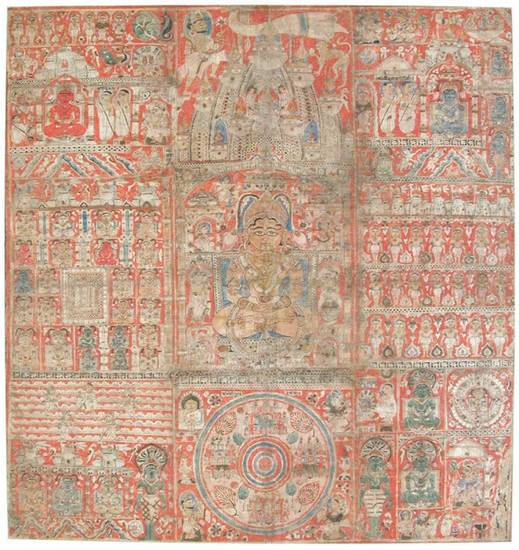
Worlds of gods and saviours
Image by San Diego Museum of Art © CC BY-NC-ND 2.0; Edwin Binney 3rd Collection
Because of the wide popularity and strong sacred associations of temple-cities, they have frequently been represented in Jain art. Artistic representations of temple-cities mainly consist of:
- pilgrimage banners – tīrtha-paṭas
- carved panels in marble
- miniature models.
These sacred objects are displayed and venerated in Jain temples throughout the subcontinent and in temples among the diaspora. Jains study and meditate on these depictions of temple-cities for two main reasons. Firstly, it allows devotees who are unable to make the journey to these often distant pilgrimage centres to gain merit. Secondly, they can mentally visit a sacred site.
Replicas of temple-cities
It is fascinating that, due to the particular importance and sacredness of certain temple-cities and venerated hills, there are Jain sites throughout India that imitate their layout and shape.
The sacred hill of Mount Bāmaṇavāḍjī in Rajasthan, for instance, which itself has nine large temples and thirty small pavilions – chatrīs – is perceived to be a replica of the sacred Sameṭa Śikhara in Bihar.
Another striking example is the collection of small shrines on raised ground inside the Śvetāmbara Dādā Baṛā Jain temple complex in Delhi. This is said to recreate in miniature form the layout of the famous Mount Śatruñjaya in Gujarat.
Reading
- Jaina Temple Architecture in India: The Development of a Distinct Language in Space and Ritual
Julia A. B. Hegewald - Monographien zur Indischen Archäologie, Kunst und Philologie series; volume 19
Stiftung Ernst Waldschmidt, G+H Verlag; Berlin, Germany; 2009
- ‘Sacred Place and Structured Space: Temple architecture and pilgrimage in Jainism’
Julia A. B. Hegewald - Victorious Ones: Jain Images of Perfection
edited by Phyllis Granoff
Mapin Publishing Pvt. Ltd and Rubin Museum of Art, New York; Ahmedabad, Gujarat, India and New York, USA; 2009
- ‘The temple cities and places of pilgrimage’
Jyotindra Jain and Eberhard Fischer - Jaina Iconography – part two: Objects for Meditation and the Pantheon
Iconography of Religions – Indian Religions series; volume 13: 13
Institute of Religious Iconography, State University of Groningen; E. J. Brill; Leiden, Netherlands; 1978
Links
- Views of Shatrunjaya temples
-
Collection of photographs of the temple-city of Mount Shatrunjaya. The pre-eminent Śvetāmbara pilgrimage site, Shatrunjaya has nearly a thousand temples. The main temple is dedicated to Ṛṣabha, the first Jina, often called Ādinātha or First Lord. These photographs are presented by Professor Frances W. Pritchett of Columbia University in New York.
- Shatrunjaya photographs
-
This set of photographs on Flickr by amaury_217 of the holy site of Mount Shatrunjaya was taken in April 2010.
http://www.flickr.com/photos/amaury_217/sets/72157624236203157/with/4734828559/
- Paṭa of Mount Shatrunjaya
-
A 19th-century Rajasthani example of a paṭa – decorative map of a holy site – of the pilgrimage centre of Mount Shatrunjaya. Owned by the Philadelphia Museum of Art in the United States, the paṭa can be enlarged by clicking on the icon of the magnifying glass. A paṭa can be used to complete a mental pilgrimage to the place depicted, which is believed to be of even more religious value than making the physical journey.
http://www.philamuseum.org/collections/permanent/68189.html?mulR=31553|11
- Mount Girnār
-
This set of photographs on Flickr by amaury_217 of the holy site of Mount Girnār was taken in April 2010.
http://www.flickr.com/photos/amaury_217/sets/72157624360343342/with/4734492857/
- Girnār temples
-
Mount Girnār is a holy site for both Jains and Hindus. The numerous Jain temples dispersed over the peaks of the mountain form a small temple-city. This 2012 photo on Flickr shows some temple compounds and the city of Junagadh below.
- Images of Shravana Belgola
-
The best-known Digambara pilgrimage site, Shravana Belgola in Karnataka is centred around the immense statue of Bahūbali. Depicted standing in deep meditation, the statue has drawn pilgrims and interest from visitors since the tenth century. This collection of drawings and photographs is presented by Professor Frances W. Pritchett of Columbia University in New York.
- Views of temples at Mukta-giri
-
The Digambara temple-city of Mukta-giri has 52 temples. Found in Madhya Pradesh, this popular pilgrimage attraction is built in a valley instead of on a high place more usual for holy sites. These images are presented by Professor Frances W. Pritchett of Columbia University in New York.
- Mukta-giri temple-city
-
The setting of the Digambara temple-city at Mukta-giri in Madhya Pradesh is a spectacular valley in the Saptura mountains. Dedicated to various Jinas, the 52 temples attract numerous pilgrims. This photograph on Flickr was taken in 2010.
- Temples at Mukta-giri
-
The Digambara temples at Mukta-giri attract many pilgrims and are built in several groups each comprising eight or so shrines very close together. The Mukta-giri temples are found in the Satpura mountain range in central India. This 2011 photo on Flickr shows how green the valley is during the monsoon season.
- Early photographs of Mount Abu
-
Historical photographs of Mount Abu, popular pilgrimage site famous for its white marble temples, presented by Professor Frances W. Pritchett of Columbia University in New York.
- Past images of Mount Abu
-
Historical photographs and drawings of Mount Abu, a famous Jain pilgrimage site boasting white marble temples with ornate carvings. These images are presented by Professor Frances W. Pritchett of Columbia University in New York.
- View of Sonā-giri
-
This 2011 photograph on Flickr captures a view of the temples of Sonā-giri. The largest temple-city in central India, Sonā-giri comprises over 100 temples scattered over rolling hills in Madhya Pradesh.
- Sonā-giri temples and pilgrims
-
This 2012 photo on Flickr captures the view from the summit of the temple-city of Sonā-giri in Madhya Pradesh. Pilgrims walk barefoot from one shrine to another in this popular Digambara site.
http://www.flickr.com/photos/gusthead/7601995854/in/set-72157629313296186
- +
- aAbhavya
- aAbhinandana
- aAbhiṣeka
- aĀcāra
- aĀcārāṅga-sūtra
- aĀcārya
- aAchalbhrata
- aAḍhāī-dvīpa
- aAdharma
- aAdho-loka
- aAdhyayana
- aAdvaita Vedānta
- aĀgama
- aAghātīya
- aAghātīya-karman
- aAgnibhuti
- aAgra
- aĀhāra
- aAhiṃsā
- aAhimsa Day
- aAjita
- aAjīva
- aAkampit
- aĀkāśa
- aAkbar the Great
- aAkṣaya-tṛtīyā
- aAlauddin Khalji
- aAlbert Einstein
- aAllah
- aAlms
- aĀlocanā
- aAloka-ākāśa
- aAmāri
- aAmbikā or Kūṣmāṇḍinī
- aAnagāra
- aAnanta
- aAnarthadaṇḍa
- aAnaśana
- aAnekānta-vāda
- aAṅga
- aAniconism
- aAnojjā
- aAntarāla
- aAntarāya-karma
- aAṇu
- aAṇu-vrata
- aAnukampā
- aAnuprekṣā
- aAnusvāra
- aApabhraṃśa
- aAparigraha
- aAra
- aĀrambha
- aĀrambhaja
- aĀratī
- aArdhamāgadhī Prākrit
- aArhaṃ
- aArhat
- aArśana-āvaraṇīya-karma
- aĀrta-dhyāna
- aĀryikā
- aĀryikā Jñānamati
- aĀśātanā
- aĀścarya
- aAscetic
- aAsceticism
- aAshram
- aAspiration
- aĀsrava
- aAṣṭa-maṅgala
- aAṣṭāpada
- aAstikāya
- aAstrolabe
- aAsura
- aAtheism
- aAticāra
- aAtiśayakṣetra
- aAtithisaṃvibhāgavrata
- aĀtma-vāda
- aĀtman
- aAuṃ
- aAurangzeb
- aAuspicious
- aAusterity
- aAvadhāna
- aAvadhi-jñāna
- aĀvaraṇī-yakarman
- aAvasarpiṇī
- aAvatāra
- aAvidyā
- aAxiom
- aĀyāga-paṭa
- aĀyambil
- aĀyu-karma
- aĀyurveda
- bBabur
- bBāhubali
- bBaladeva
- bBālāvabodha
- bBandha
- bBasadi
- bBazaar
- bBhadrankarvijay
- bBhagavant
- bBhaktāmara-stotra
- bBhakti
- bBhale
- bBharata
- bBhāṣā
- bBhāṣya
- bBhaṭṭāraka
- bBhāva
- bBhāva-pūjā
- bBhāvanā
- bBhavana-vāsin
- bBhavya
- bBhavyatva
- bBhaya
- bBhoga-bhūmi
- bBhogopabhoga
- bBodhi
- bBollywood
- bBrahmā
- bBrahma-deva
- bBrahmacārī
- bBrāhmaṇa
- bBraj Bhāṣā
- bBright fortnight
- bBritish Raj
- bBuddha
- bBuddhi-sagar
- bBuddhism
- bBuddhist
- cCaitya
- cCaityavāsin
- cCakravartin
- cCakreśvarī
- cCāmara
- cCandanā
- cCandragupta
- cCandraprabha
- cCanon
- cCāritra
- cCāritramohanīya-karman
- cCarũrī
- cCaste
- cCaturvidha-saṅgha
- cCaturviṃśati-stava
- cCāturyāma
- cCE
- cCelibacy
- cCha
- cChadmastha
- cChastity
- cCheda-sūtra
- cChristian
- cChristianity
- cClergy
- cCloning
- cColophon
- cCommentary
- cConch
- cConfession
- cCongregation
- cConsecration
- cCosmology
- cCremation
- cCrore
- cCult
- cCūrṇi
- dDādā-guru
- dDalit
- dDāna
- dDaṇḍa
- dDark fortnight
- dDarśana
- dDarśanamohanī-yakarman
- dDaśa-lakṣaṇa-parvan
- dDeity
- dDelhi Sultanate
- dDerāsar
- dDeśāvakāśika-vrata
- dDetachment
- dDevanāgarī
- dDevānandā
- dDevarddhi-gani
- dDevotee
- dDhamal
- dDhanuṣ
- dDhāra
- dDharma
- dDharma-dhyāna
- dDharma-sāgara
- dDharmastikaya
- dDhātakīkhaṇḍa
- dDholak
- dDhyāna
- dDiaspora
- dDig-vrata
- dDigambara
- dDīkṣā
- dDisciple
- dDīvālī
- dDivya-dhvani
- dDNA
- dDoctrine
- dDogma
- dDonor
- dDoṣa
- dDravya
- dDravya-pūjā
- dDrone
- dDuṣamā
- dDuṣamā-duṣamā
- dDuṣamā-suṣamā
- dDveṣa
- dDvīpa
- eEast India Company
- eEightfold Path
- eEkānta-vāda
- eEkendriya
- eElder
- eElders
- eEschatology
- eEtc up to
- fFarmān
- fFast
- fFatehpur Sikri
- fFestival
- fFestschrift
- fFiruz Shah
- fFly-Whisks
- fFolio
- fFour Noble Truths
- gGaccha
- gGaṇa
- gGaṇadhara
- gGanadharavada
- gGaṇeśa
- gGaṇin
- gGarba
- gGarbha
- gGarbha-gṛha
- gGaruḍa
- gGati
- gGene
- gGenomics
- gGhātī-yakarman
- gGhātīya
- gGhaznavid
- gGhiyasuddin Tughlaq
- gGhurid
- gGloss
- gGotra-karma
- gGujarāt
- gGujarati
- gGuṇa
- gGuṇa-sthāna
- gGuṇa-vrata
- gGupti
- gGuru
- gGuruṇī
- hHagiography
- hHajj
- hHaṃsa
- hHaribhadra
- hHariṇaigameṣin
- hHasta
- hHeresy
- hHiṃsā
- hHindi
- hHindu
- hHinduism
- hHīravijaya
- hHoroscope
- hHrīṃ
- hHumayun
- hHymn
- iIconoclasm
- iIconography
- iIdol
- iIndian Independence
- iIndology
- iIndra
- iIndrabhūti Gautama
- iIndriya
- iInitiation
- iIntercession
- iInvocation
- iIQ
- iIslam
- iIslamicate
- iIṣṭadevatā
- iĪśvara
- jJagat
- jJahangir
- jJain
- jJaina Devanāgarī
- jJaina Śaurasenī
- jJaina-dharma
- jJainaśāsana
- jJainness
- jJaisalmer
- jJamāli
- jJambū-dvīpa
- jJames Burgess
- jJanma
- jJanma-kalyāṇa
- jJarā
- jJāti
- jJina
- jJina-āgama
- jJina-bhavana
- jJina-bimba
- jJina-mātā
- jJinacandra-sūri
- jJinadatta
- jJinaprabha
- jJīva
- jJñāna
- jJñāna-āvaraṇīya-karma
- jJñāna-āvarṇiya
- jJñānsundar
- jJyotiṣka
- kKāla
- kKālakācārya-kathā
- kKālidāsa
- kKalpa-sūtra
- kKalpa-vṛkṣa
- kKalyāṇaka
- kKalyanvijay
- kKamaṇḍalu
- kKamaṭha
- kKarma
- kKarma-bhūmi
- kKarma-grantha
- kKarma-prakṛti
- kKarma-vāda
- kKarmon
- kKarnataka
- kKaṣāya
- kKathā
- kKāvya
- kKāya
- kKāyotsarga
- kKeśa-loca
- kKetu
- kKevala-jñāna
- kKevalin
- kKhalji
- kKharatara-gaccha
- kKnowledge
- kKriyā
- kKriyā-vāda
- kKṛṣṇa
- kKṣamā-śramaṇa
- kKṣapakaśreṇi
- kKṣatriya
- kKṣullaka
- kKulakara
- kKundakunda
- kKunthu
- lLabdhi
- lLaity
- lLakh
- lLāñchana
- lLands of Action
- lLaukāntika
- lLavaṇa-samudra
- lLeśyā
- lLiṅga
- lLinguistics
- lLoka
- lLoka-ākāśa
- lLoka-puruṣa
- lLoka-vāda
- lLotus
- lLotus lake
- mMadhya-loka
- mMahā-videha
- mMahā-vrata
- mMahābhārata
- mMahāmastakābhiṣeka
- mMāhārāṣṭra
- mMāhārāṣṭrī Prākrit
- mMahattarā Yākinī
- mMahāvīr Jayantī
- mMahāvīra
- mMakāra
- mMakkhali Gośāla
- mMalli
- mMāna-stambha
- mManaḥ-paryāya-jñāna
- mMaṇḍala
- mMaṇḍapa
- mMandit
- mMaṅgala
- mMantra
- mMantras
- mManuṣya-loka
- mMarāṭhī
- mMārgaṇā
- mMartyr
- mMarudevī
- mMaṭha
- mMati-jñāna
- mMauryaputra
- mMecca
- mMendicant lineage
- mMetarya
- mMiracle
- mMithyādṛṣṭi
- mMohandas Gandhi
- mMohanīya-karma
- mMokṣa
- mMonastic order
- mMonasticism
- mMonk
- mMonotheism
- mMosque
- mMount Meru
- mMount Sammeta
- mMṛgāvatī
- mMughal
- mMuhammad
- mMuhammad bin Tughlaq
- mMuhpattī
- mMūla-sūtra
- mMūlaguṇa
- mMumbaī
- mMuni
- mMunisuvrata
- mMurad Bakhsh
- mMūrti-pūjaka
- mMuslim
- mMysticism
- nNābhi
- nNāga-kal
- nNāgapurīya Tapā-gaccha
- nNāgarī
- nNāma-karma
- nNamaskāra-mantra
- nNami
- nNandīśvara-dvīpa
- nNandivardhana
- nNandyāvarta
- nNāraka
- nNāraki
- nNasalisation
- nNātha
- nNavrātrī
- nNaya-vāda
- nNemi
- nNidāna
- nniggaṃthāṇa vā 2
- nniggaṃtho vā 2
- nNigoda
- nNihnava
- nNikṣepa
- nNirgrantha
- nNirjarā
- nNirvāṇa
- nNiryukti
- nNiṣidhi
- nNitya
- nNiyati
- nNo-kaṣāya
- nNudity
- nNun
- oOcean of milk
- oOmniscience
- oOrdination
- ppa°
- pPadmaprabha
- pPadmāsana
- pPadmāvatī
- pPādukā
- pPalanquin
- pPalette
- pPañca-muṣṭi
- pPāṇḍava
- pPaṇḍit
- pPandit Dalsukh D. Malvania
- pPandit Sukhlalji
- pPāṇipātra
- pPāpa
- pParamātman
- pParameṣṭhin
- pPāraṇā
- pParigraha
- pPariṇāma
- pParīṣaha
- pParokṣa
- pPārśva
- pPārśvanātha
- pParyāya
- pParyuṣaṇ
- pPaṭa
- pPatan
- pPātra
- pPenance
- pPersian
- pPhala
- pPhilology
- pPicchikā
- pPilgrimage
- pPīr
- pPolymath
- pPoṣadha
- pPossession
- pPothī
- pPrabhas
- pPradakṣiṇā
- pPradeśa
- pPrākāra
- pPrakīrṇaka-sūtra
- pPrākrit
- pPramāda
- pPramukhā
- pPrati-vāsudeva
- pPratikramaṇa
- pPratimā
- pPratiṣṭhā
- pPratyākhyāna
- pPratyakṣa
- pPravacana
- pPrāyaścitta
- pPrayer
- pPre-modern
- pPreach
- pPredestination
- pProtestant
- pProvenance
- pPudgala
- pPūjā
- pPujārī
- pPukharavara-dvīpa
- pPuṇya
- pPūrva
- pPuṣkara-dvīpa
- pPuṣpadanta
- pPyre
- qQur’an
- rRāga
- rRāhu
- rRainy season
- rRajasthan
- rRajasthani
- rRājimatī
- rRajoharaṇa
- rRajput
- rRāma
- rRāmāyaṇa
- rRangoli
- rRās-garbā
- rRasa
- rRathanemi
- rRatna-traya
- rRātri-bhojana
- rRaudra-dhyāna
- rRecto
- rRelic
- rRenunciation
- rRetroflex
- rRevatī
- %Ṛg-veda
- rRite
- rRosary
- %Ṛṣabha
- %Ṛṣabhanātha
- rRupee
- sSaciyā Mātā
- sSādhu
- sSādhvī
- sSāgāra
- sSaint
- sŚaivaism
- sŚaka-saṃvat
- sSallekhanā
- sŚalya
- sSamacatuṣṭha
- sSamādhimaraṇa
- sSamaṇi
- sSāmarambha
- sSamavasaraṇa
- sSāmāyika
- sSaṃbhava
- sSamiti
- sSaṃjñā
- sSaṃkalpaja
- sSaṃsāra
- sSamudghāta
- sSaṃvara
- sSaṃvega
- sSamyak-cāritra
- sSamyak-darśana
- sSamyak-jñāna
- sSamyaktva
- sSaṃyama
- sSanctuary
- sSandalwood
- sSaṇgha
- sSanskrit
- sSant
- sŚānti
- sSapta-bhaṅgi-naya
- sSārambha
- sSarasvatī
- sSarvajña
- sSāsan-devi
- sŚāsana-devatā
- sŚāstra
- %Ṣaṭ-jīvanikāya
- sSatī
- sSatīmātā
- sSatya
- sSchism
- sScribe
- sScripture
- sSect
- sSecularism
- sŚenāī
- sSermon
- sŚeṣavatī
- sSevā
- sSeven fields of donation
- sShah Jahan
- sShantidas Jhaveri
- sShrine
- sSiddha
- sSiddha-śilā
- sSiddhacakra or Navadevatā
- sSiddhānta
- sSiddhārtha
- sSiddhi
- sSikh
- sSikhism
- sŚikṣā-vrata
- sŚīla
- sSin
- sSindh
- sŚītala
- sŚiva
- sSkandha
- sSomanatha
- sŚraddhā
- sŚramaṇa
- sŚrāvaka
- sŚrāvakācāra
- sŚrāvikā
- sŚreyāṃsa
- sŚrī
- sŚrīvatsa
- sŚruta-jñāna
- sŚruta-pañcamī
- sSthānaka-vāsin
- sSthāpanācārya
- sSthāvara
- sSthavira
- sSthiti
- sStrīmukti
- sStūpa
- sSubcontinent
- sSudarshana
- sŚuddhi
- sSudharma
- sŚūdra
- sSufism
- sSukha
- sŚukla-dhyāna
- sSulasā
- sSultan
- sSumati
- sSundarśrī
- sSupārśva
- sSūri
- sSuṣamā
- sSuṣamā-duṣamā
- sSuṣamā-suṣamā
- sSūtra
- sSuyam me ausam! Tenam bhagavaya evamakkhayam
- sSvādhyāya
- sSvāhā
- sSvastika
- sŚvetāmbara
- sŚvetāmbara Terāpanthin
- sŚvetāmbaras
- sSwan
- sSyād-vāda
- tTabla
- tTantra
- tTapā-gaccha
- tTapas
- tTāraṇ Svāmī Panth
- tTattva
- tTattvārtha-sūtra
- tTemple
- tTemple-city
- tThe Enlightenment
- tTheology
- tThree worlds
- %Ṭīkā
- tTilaka
- tTīrtha
- tTīrthaṃkaranāma-karman
- tTīrthankara
- tTransliteration
- tTrasa
- tTrasa-nāḍī
- tTriśalā
- tTriṣaṣṭi-śalākā-puruṣa-caritra
- tTti bemi
- tTughlaq
- tTunk
- uUdumbara
- uUniversal History
- uUpādhyāya
- uUpāṅga
- uUpaniṣads
- uUpāsaka
- uUpasarga
- uUpāśraya
- uŪrdhva-loka
- uUtsarpiṇī
- uUttarādhyayana-sūtra
- vVāhana
- vVaimānika
- vVairāgya
- vVaiṣṇava
- vVaiśramaṇa
- vVaiśya
- vValabhī
- vVanaspatikāya
- vVandana
- vVaṇik
- vVarṇa
- vVāsudeva
- vVāsupūjya
- vVayubhūti
- vVeda
- vVedanīya-karma
- vVegetarianism
- vVehicle
- vVernacular
- vVerso
- vVidyā
- vVidyā-devī
- vVihāra
- vVijñapti-patra
- vVikrama-saṃvat
- vVikṛti
- vVimala
- vVinaya
- vVipāka
- vVirji Vora
- vVirodhaja
- vVīrya
- vVisarga
- vViṣṇu
- vVītarāga
- vVizier
- vVotive
- vVow
- vVrata
- vVS
- vVyakta
- vVyantara
- vVyasana
- yYakṣa
- yYakṣī
- yYantra
- yYaśoda
- yYaśovijaya
- yYati
- yYātrā
- yYoga
- yYoginī
- yYojana



